IPTV and Pluggable Optics
The MSO arena is undergoing a transition to Internet Protocol televison (IPTV). IPTV combined with other OTT traffic will accentuate the challenge of rapidly increasing IP traffic as residential customers access the vast selection of rich media content on the Web. In 2012, approximately 64 percent of consumer IP traffic ( Cisco VNI 2011) will be video content delivered to PCs, tablets, smartphones and IPTVs.
IPTV and the rapid adoption of such devices as smartphones and tablets combined with the emergence of video streaming giants like Netflix, YouTube and Hulu continues to drive the relentless growth in IP traffic shown in Figure 1.
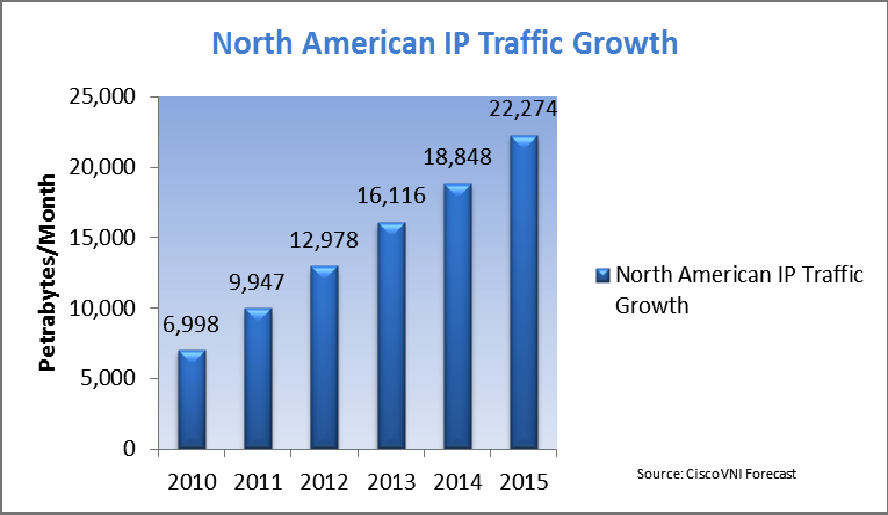 |
|
FIGURE 1: North American IP Traffic Growth |
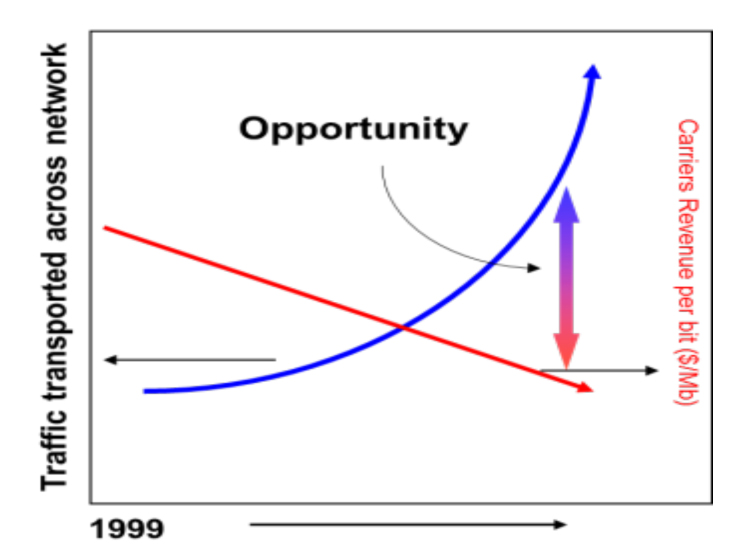 |
| FIGURE 2: Traffic Transported Vs. Revenue Per Mb |
Adding to the rapid growth of residential IP traffic on MSO networks is the impressive growth being achieved by major cablecos in the of business-services market. 2010 was the first year Comcast, Time Warner Cable and Cox each generated more than $1 billion in business-services revenues (see Figure 2).
During this same period, the MSOs have faced the market reality of dropping revenues per megabit. This reduction is driven by dynamics of the market, where consumers increasingly have a choice of broadband carriers, especially in urban markets where consumers typically have at least two providers from which to choose.
Network Convergence
Given the dynamics of relentless pressure to add network capacity to handle growing traffic and dropping revenues per megabit, MSOs constantly are seeking new approaches to network deployment to drive costs out of the network and thus reduce the cost per megabit transported. One such approach deployed recently by large providers is a converged IP router and optical transport network architecture.
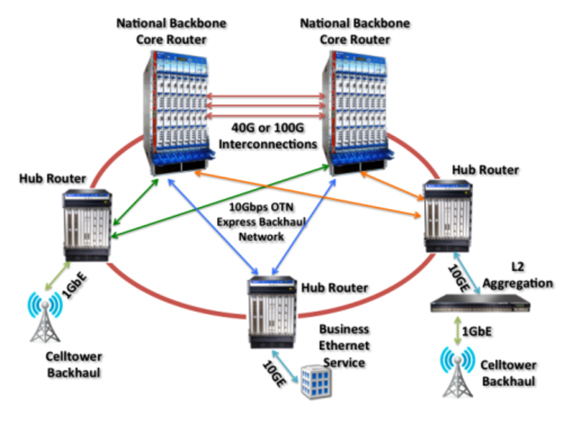 |
| FIGURE 3: Traditional Network Architecture |
Traditional architectures deployed by MSOs have maintained a separation between the IP router and the optical transport network. During the last several years, the development of ITU optical transport network (OTN)-enabled tunable XFPs and “touchless” wavelength-routing transport capabilities has led many carriers to begin the deployment of a converged network architecture (see Figure 3).
Network Architectures
The migration from synchronous optical network (SONET) services to Ethernet services changed the traffic engineering and network architecture design for carriers in significant ways. Traditionally, dense wavelength division multiplexing (DWDM) networks were built in a ring topology, typically to provide SONET shared ring-switching protection; however, IP router architectures typically are deployed in a star or dual-homed configuration with dynamic IP protection at the packet level. Fiber networks deployed today largely have interconnected ring topologies. As Ethernet-based networks are overlaid on ring-based DWDM architectures, inefficiencies can result from “ring hopping” across multiple physical fiber rings when 10 Gbps circuits are deployed between distant points, especially between regional and core routers as shown in Figure 4.
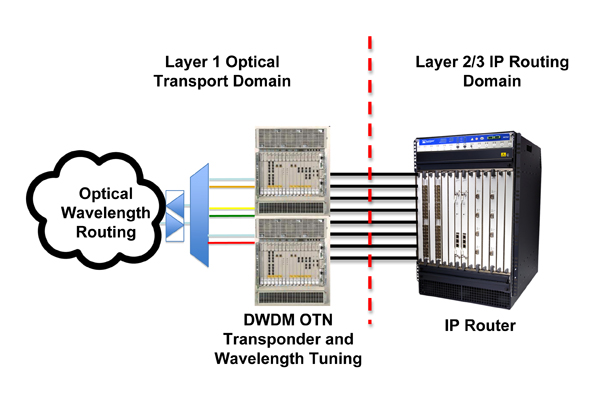 |
| FIGURE 4: Typical IP Router Network Architecture |
Technologies
These inefficiencies of optical wavelength routing result in longer 10G, 40G and 100G DWDM wavelength paths, traversing multiple optical amplifiers and wavelength routing nodes called reconfigurable optical add-drop multiplexers (ROADMs), each of which add noise and distortion to the DWDM signal, resulting in bit errors.
Convergence of the IP-routing layer and the optical-transport layer relies on several technological advances, integration and operations practices to enable wavelength routing on these challenging optical networks. This converged network is called an IP over dense wavelength division multiplexed (IPoDWDM) network1.
Pluggable, Tunable Optics
All IP router optical interfaces are designed around ubiquitous, pluggable sockets, allowing the customer to choose the optical performance desired based on the type of pluggable interface chosen. In order for IP routers to deploy converged IPoDWDM networks, the following three technologies are required to be integrated into the pluggable optical interface:
• Full capability to tune across all 96 DWDM wavelengths available for transport;
• Forward error correction to correct for bit errors created by the optical network wavelength amplification and wavelength routing degradations; and
• ITU-T standards-compliant protocol framing, timing, alarming and performance management for network management.
MSOs now have access to commercially available pluggable optical modules that incorporate each of these technologies in a standard pluggable interface, compatible with any router with a compliant optical-pluggable form-factor socket. Traditionally, these optical transport technologies are handled by specialized, standalone transponder network elements. While providing the desired transport functions, transponders burden the network with substantial cost for equipment capital, rack space and ongoing operating expenses for power and cooling.
Integrating these technologies from the transponder network element to the pluggable optical interface reduces network cost for 10 Gb transport by 50 percent and reduces power consumption by 85 percent, while the transport network rack footprint is reduced by 50 percent2. This converged IPoDWDM architecture is shown in Figure 5.
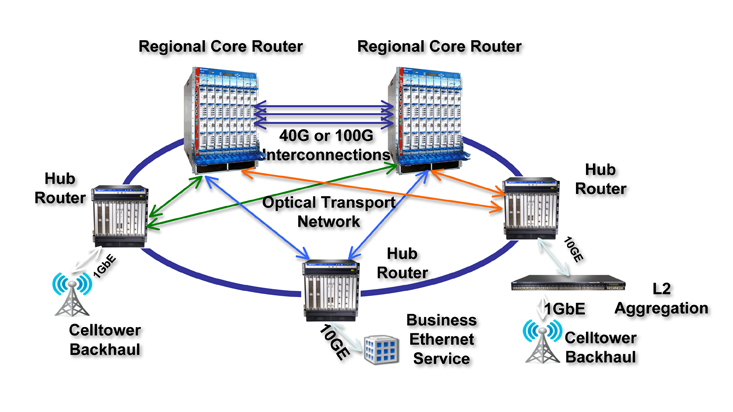 |
| FIGURE 5: Converged IP Router And Optical Transport Architecture |
The deployment of converged IP routing and optical transport networks represents an evolutionary and non-disruptive approach for MSOs and other carriers to bridge the gap between rising traffic growth and the falling-price-per-megabit trend. Implementation of the optical transport functions into a standard pluggable optical interface compatible with existing IP router hardware and software provides a seamless migration opportunity to achieve network convergence across multiple vendors and router types.
Majid Mir is senior director/Customer Solutions at Menara Networks. Contact him at majid@menaranet.com.
1IPoDWDM (2011). http://en.wikipedia.org/wiki/IPoDWDM.
2Nathan, Sri (2008). Capital and Operational Economic Benefits of MSA Pluggable Transceivers with Integrated OTN OAM and FEC, http://menaranet.com/papers/Menara_OTN_Pluggable_Economic_Benefits_v2.pdf.